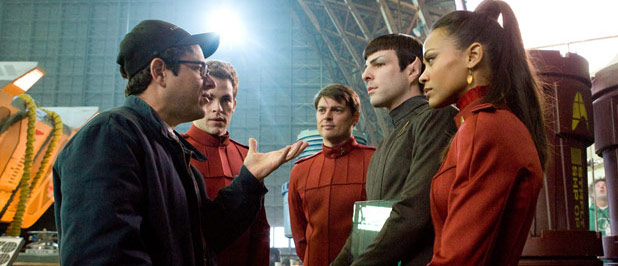Abrams Talks The Technical Side Of Making 'Star Trek'

In an exclusive interview with Post Magazine, 'Star Trek' director J.J. Abrams talks about the technical side of shooting 'Star Trek'.
Post: You shot this 35mm anamorphic when so many sci-fi films are now shot digitally. Why?
ABRAMS: "I knew this movie would have a great deal of computer generated visual effects in it and I knew that's the reason Star Wars films have been shot with a great deal of blue- or greenscreen and digitally, and I was nervous about that. I wanted this film to feel distinct from those. I didn't want to have a given about how many effects would be created. I didn't want there to be this artiface to the movie, even though it's called Star Trek, even though it's a fantasy future sci-fi. I wanted it to feel as sort of tangible and gritty and real as possible. "As [DP] Dan Mindle said, he wanted it to have guts. And so for me the approach to the movie was, I wanted wherever we could to be practical and to be analog, because there was going to be a whole bunch of virtual and digital, so wherever we could add the realism by literally making it real I thought would help the aesthetics. So we built sets and found locations as much as possible and dressed them or extended sets."
Post: You used a lot of lens flares.
ABRAMS: "We added them on the set, not post, because I wanted to give the film that sense of unpredictability. There's something about lens flares — beyond the aesthetic of 'the future's so bright you can't contain it in the frame.' I wanted that beautiful interaction between light and glass that you can't control, to add to the tangible analog human imperfect quality that's increasingly hard to find in these kind of films."
Post: Tell us about the editing process. The film is edited by Maryann Brandon, who collaborated with you on Alias and on MI3, and Mary Jo Markey, who collaborated with you on Alias and on MI3.
ABRAMS: "When I was doing MI3 we met with all these very impressive editors and the instinct to say, 'Let's go for an obvious big name,' was seductive. But I also knew that we had a short post, and there was so much that was new for me since it was my first movie — I needed that shorthand, and I'd worked with both of them for years and we had that shorthand already. "We'd done Alias together, which was in the same genre as MI3, and I thought, I know how to cut sequences with them, and just as Alias was inspired by Mission: Impossible, MI3 was going to be inspired by Alias in some ways. So I felt using two familiar editors would give me my comfort zone, and they also have great ideas and always present me with options I didn't expect. So it was the same thing here. We cut on Avid, and they did a fantastic job." [They used Mac-based Media Composer Adrenalines running V.2.7.5.]
Post: Where did you do the post? How long was the process?
ABRAMS: "We cut on the Paramount lot and post was about six months. But post on a film like this is deceptive because you start when you shoot and then when you stop shooting you're still directing. With ILM we were directing shots and animation up until December, so it was more like nine months of post and production simultaneously." (source Post Magazine)
Read the full article here.

